When parents begin to understand the stages of labor and how birth typically unfolds, it gives them a better idea of what labor may be like for them. Once moms know what to expect, they become motivated to learn ways to make their birth more enjoyable and less painful.
Dads especially appreciate learning about the stages of labor because once they understand how childbirth works, it helps them to understand how to be a better birth partner. Dads want to be a helpful asset in the birthing room.
This blog post explores the nuts and bolts of the stages of labor, but also helpful tips for coping, so parents will have the best birth possible.
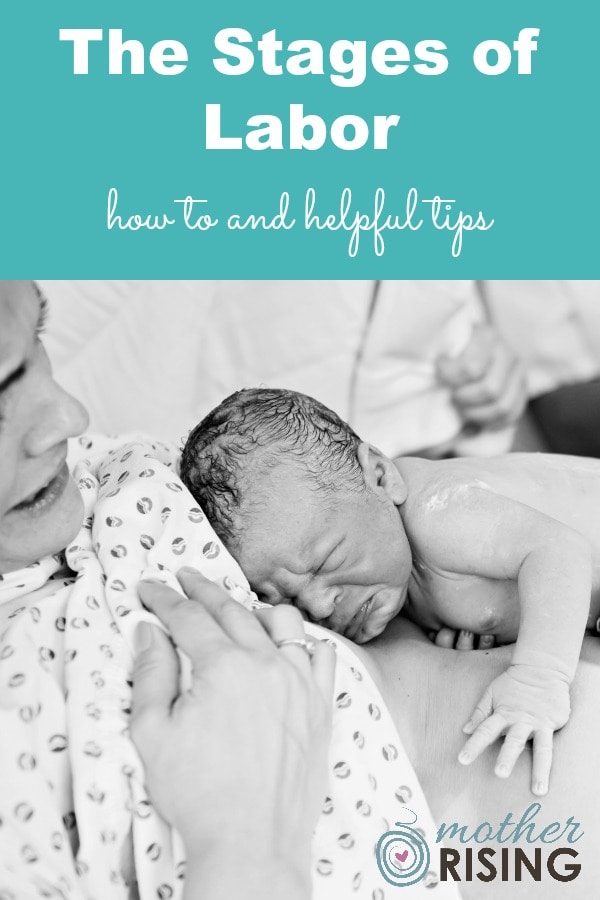
The Stages of Labor: How to and Helpful Tips
The three stages of labor are…
Stage 1
Stage 2
Pushing and the Birth of the Baby
Stage 3
Stage 1
The first stage of labor is devoted to powerful contractions that open the cervix to 10 cm. The cervix is the opening of the uterus, which is the strong muscle where your baby has been growing. Besides dilating the cervix, the first stage of labor also positions the baby in the best possible position for the next stage, pushing and the birth of the baby. Stage 1 is also known as labor.
Stage one is the longest stage of labor and where parents will spend the most of their time. Because it’s so long and carried, it’s been further broken down into three sections – early labor, active labor and transition. Do any of them sound familiar?
Early Labor
Early labor, one of the longer parts of the stages of labor, is when contractions are further apart, perhaps 5-7 minutes apart. Contractions are also short, around 30 seconds long. They’re also more mild, and women are typically able to talk and walk through them.
In early labor women also begin to experience many other signs of labor and the cervix is usually dilated (opened) to less than six centimeters.
One of the best things to do in early labor to cope is to rest and pretend that nothing is happening. In fact, I often say that sleeping is the secret to coping through early labor.
- For a checklist of symptoms of early labor click here.
- If you’re unsure if what you’re experiencing is braxton hicks contractions or the real deal check this out.
- If you’re not in labor but wishing you were, here’s a list of activities to do while waiting for the labor. 😉
- For more information, ideas, and activities to cope through early labor head on over here.
Active Labor
Active labor is when the cervix has opened to 6 centimeters (give or take), contractions are around 3-5 minutes apart. and each contraction is about 60 seconds long.
In early labor, women are able to walk and talk through their contractions. At this point, however, because contractions are longer, stronger and closer together, she can no longer walk and talk during contractions. Between contractions, she may still be her normal self and able to relax. During contractions, however, all her focus and energy goes within to work through each wave that comes.
Many parents wonder how far apart contractions should be before heading to the hospital. Most parents go to the hospital during active labor. Some wait until transition, but are often working closely with their care providers to avoid a having a “car baby”. 😉
For a long list of symptoms of active labor, and tips to cope through it all, check out my post Active Labor: How to Cope, When to Go and More!
Transition
Transition is the shortest portion of the first stage of labor, but the most challenging. Contractions are around 90 seconds long, 2-3 minutes apart and the cervix is 8-10 cm dilated.
Typically, transition is often when women “give up” on a natural birth, ask for an epidural, and say “I can’t do this anymore.” Birth plans fly out the window, and women look for a way out. Women may feel hot, cold, sweaty, nauseous, and may even throw up. Crying is another good sign that she’s in transition.
At this point, what may have been working is absolutely not working anymore which means a woman’s support team needs to step up their game.
For a more detailed post and MUST READ information about transition and how to cope through it, check out my post called how to get through transition without an epidural.
(Seriously… read it! And read the comments too. They’re amazing and so encouraging!)
Stage 2
The second stage of labor is when the cervix is completely open to 10 cm, which allows baby to move down through the pelvis, pushing, and the birth of the baby (although I have found success pushing prior to that point, which is not necessarily recommended lol).
Typically, women feel relieved to reach this point. Transition is over, and the end is near. Instead of labor happening to them, they really appreciate taking a more active role in the process.
During pushing contractions may space out a tiny bit. Mothers are exhausted, and if she is able to relax effectively between contractions, she may even find herself falling asleep between pushes!
If you would like these questions answered…
- How do I know when to push?
- What if I don’t feel the urge to push?
- How long will it take to push out my baby?
- Will I poop in front of everybody?
- How can I prevent tearing?
… make sure to read my post about how to push your baby out. Make sure to read my post about mistakes to avoid during pushing too. It’s great info!
Stage 3
The third stage of labor, the delivery of the placenta, is the most overlooked stage of birth. It’s also the shortest, lasting only minutes.
Skin-to-Skin
During the third stage of labor, while waiting on the cord to stop pulsing and for the placenta to be delivered, the best place for baby to be is skin-to-skin on mom’s chest (or belly if the cord isn’t long enough).
Skin-to-skin contact helps regulate baby’s breathing, temperature and gives mother and baby peak amounts of oxytocin – which is a hormone helpful for bonding, breastfeeding success, and feeling amazing. Oxytocin also helps mom’s uterus to contract, expel the placenta, heal, and shrink back to where it needs to be.
Skin-to-skin is where it’s at!
NOTE: Don’t forget, even if you find yourself in the OR for a cesarean birth, you can still ask for skin-to-skin. If for whatever reason mom cannot have immediate skin-to-skin, the next best place for baby to be is on dad’s chest. Dad – take your shirt off and enjoy that freshly born baby. Your oxytocin will go through the roof!
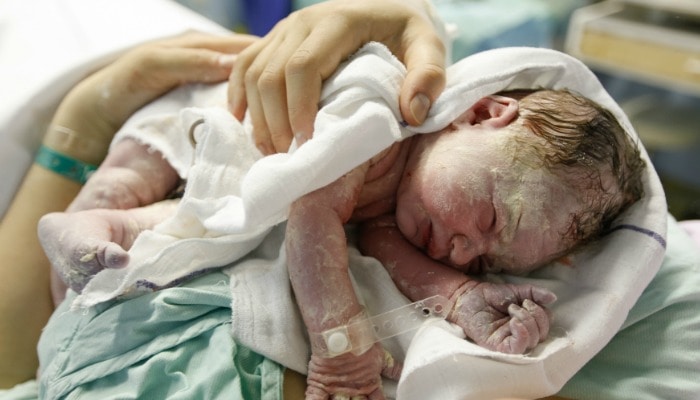
Delayed Cord Clamping
While waiting on the placenta to be delivered, let’s talk about when to cut the cord.
Immediately following the birth of the baby, one of the first things care providers like to do, even before handing baby to mom, is to immediately cut the cord. If possible, it is best to wait at least two minutes to cut the cord, but hopefully longer. Ideally, wait to clamp and cut the cord until it has completely stopped pulsing.
Have a prenatal conversation with your care provider about how they operate, and be sure to read my post about delayed cord clamping myths, busted!
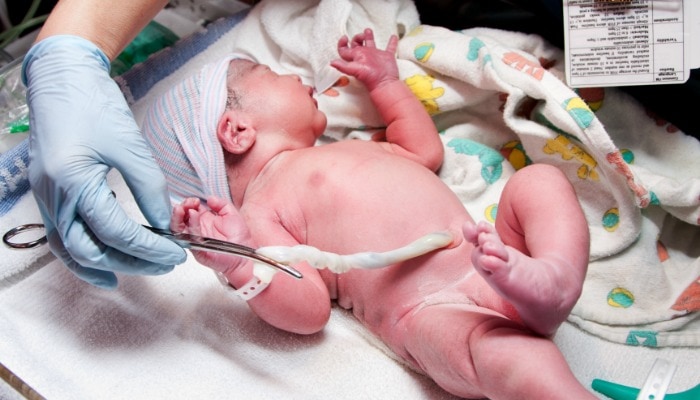
Delivery of the Placenta
Finally, at around 3-15 minutes after the birth of the baby, a mother will begin to feel strong contractions, reminding her of the labor she just completed. These contractions have a purpose, however, and are helping to expel the placenta, and at the same time prevent excessive bleeding from where the placenta was previously attached to the uterus.
Thankfully, the placenta has no bones so it’s relatively easy to push out of the vagina, even after just giving birth. And yes, there’s often a tiny bit of pushing involved.
Because you just gave birth, it will probably sting. But that’s it and you’re done! Hooray! You’re no longer pregnant!
PS – Many care providers use an IV of Pitocin to reduce the chance of postpartum hemorrhage. Research shows a link to postpartum depression and the use of Pitocin. Do your research to make an informed decision!
Uterine Massages
At this point that uterine massages become a necessary evil. But let me clarify – it’s not a massage. Uterine massages don’t feel nice.
Every 15 minutes or so during the first couple hours, the uterus will be checked and “massaged” to make sure that it is shrinking back instead of remaining boggy and filling with blood.
Care providers absolutely have their patient’s best interest in mind – they’re making sure we don’t have a postpartum hemorrhage. So as much as you can, be kind to them when you receive a “massage”. They mean well. 😉
The Stages of Labor: How to and Helpful Tips
To recap, here is how the stages of labor typically unfolds.
Stage 1
Stage 2
Pushing and the Birth of the Baby
Stage 3
Leave a Comment
Thanks for reading! Leave me a comment and let me know if you have any questions. I’d love to hear your thoughts or hear about your experience.



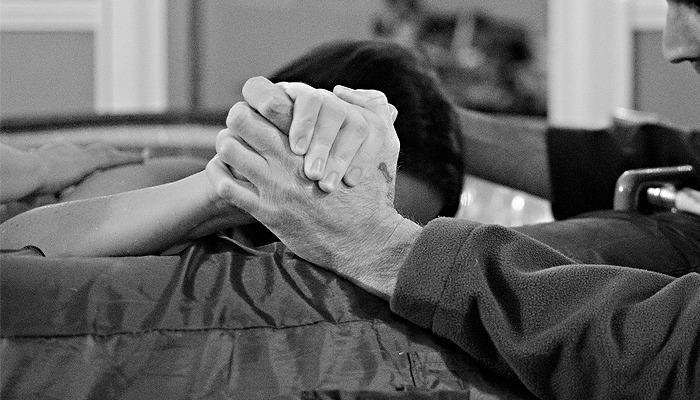
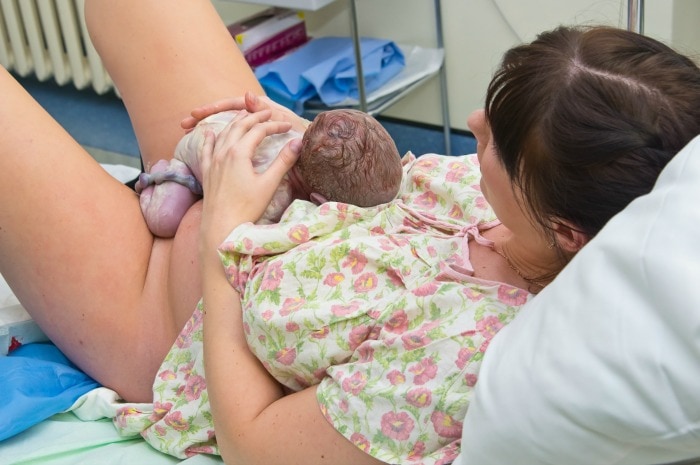
Stephanie
Friday 13th of April 2018
Thank you so much for writing this up. I'd love to have a Douala or midwife but that's just not in my budget unfortunately. As a first time mom I'm grateful for the insight and information that you kindly shared.
Bryanne
Wednesday 21st of March 2018
I don't ever really comment on blogs, but I just had to say Thank you for writing this! I'm due in mid May and I am hoping to be able to do a home birth with my midwives and support system.
Your article has been so helpful. It gives me a much clearer picture of what to expect, and arms me with the comfort of being informed. You shared it very clearly with descriptive visuals. Thank you so much and I will be sharing it!
B
Lindsey
Wednesday 21st of March 2018
You're welcome! I'm glad you commented. It means a lot to me!
Maggie
Wednesday 20th of September 2017
So once you are at 10 cms, but not yet ready to push, are the contractions similar in intensity to transition? You wrote they may space out,. Any other words in this?
Lindsey
Thursday 21st of September 2017
It's still intense. But sometimes spaced out.
Amanda
Monday 18th of September 2017
Hah! I didn't know I had moved between stages. Despite all of the reading I had done, I still didn't believe I was in labor. My husband made me go to the hospital. Good thing he did. I was holding our child in my arms within 90 minutes of our arrival. Baby was born 5 weeks early, tiny but healthy. We live in Bush Alaska. 90 minutes is cutting it CLOSE by standards here. Our experience was so good! I feel we had tthe best of both worlds when it came to where/how we delivered. Our doctor, tiny hospital, and Alaska natural/chill/independent mindset made it feel just like a home birth and with all the same options.